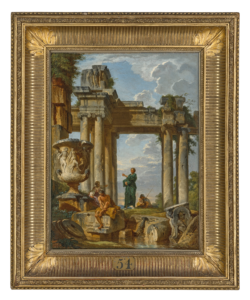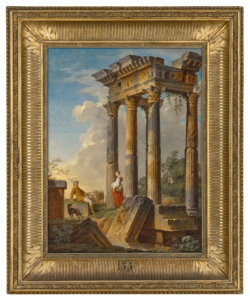Classical Ruins at Strawberry Hill
Written by Cas Bradbeer, Assistant Curator
Two exquisite paintings by Giovanni Paolo Panini will be on display from 20 April 24 at Strawberry Hill on long-term loan from a private collector. They boast a prestigious provenance, having once adorned the walls of Northwick Park in the esteemed collection of the Barons Northwick. Until recently they have been kept at National Museum Cardiff, and now they will take pride of place on a wall all to themselves in Strawberry Hill’s Green Closet.
They will join a carefully curated display that reflects the various fascinations of Horace Walpole, such as the work of William Hogarth. One of his major interests, which he shared with his father, was representations of landscapes populated with ruins. Such works demonstrate the Neoclassical taste that Walpole developed through his classical studies and the Grand Tour. By 1774 and until 1842, the Green Closet contained dozens of these works, such as representations of Roman ruins by Andrea Locatelli.
As noted in his published correspondences, Horace Walpole bought several paintings by Panini while in Italy. The 1736 inventory of his father’s collection at Walpole House in Chelsea also located ‘Two pieces of Ruins with figures’ by Panini.
In the Green Closet, these paintings will join another small painting of classical ruins this time by the renowned Dutch painter Cornelis van Poelenburgh. Like the Panini loans, this painting is a fictionalised architectural scene, known as a capriccio—a genre developed by Panini from his training in trompe l’oeil architectural painting.
There is a sweetness and lightness to Panini’s paintings that we have on loan, both in palette and subject matter. One delightfully features sheep and a dog flanking two shepherds, while the other humorously shows a scene of five figures ‘conversing’ despite none of them looking at one another but instead pondering and gesturing to various parts of the ancient ruins.
These delightful works of art provide us with the opportunity to increase representation of Walpole’s interest in classicism, which intertwined with his passion for the Gothic. Their presence in the house broadens our understanding of Walpole’s multi-layered taste, including more antiquarian aesthetics to better reflect the original atmosphere of Strawberry Hill.

Classical Ruins with Figures Conversing, 1739, Giovanni Paolo Panini. On loan from a private collection.

Classical Ruins with Shepherds, 1740-45, Giovanni Paolo Panini. On loan from a private collection.